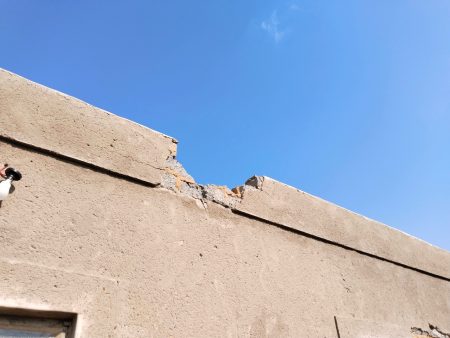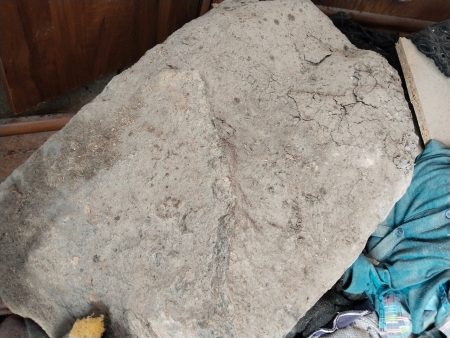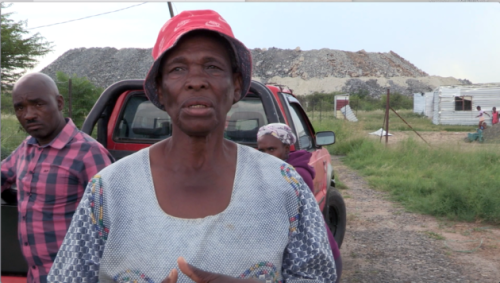By: Gillian Schutte
At the recent State of the Nation Address, President Cyril Ramaphosa promised that the country would “breathe new life into mining.” His speech painted a vision of economic renewal and job creation—a promise that was meant to elevate the nation. Yet, for those living on the fringes of the extractive industry, such as the residents of Leokeng, this promise remains hollow.
Read more: SAMANCOR Chrome Ltd’s Open Cast Blasting Turns Village in North West into a WarzoneLeokeng is a small village near Mooinooi where parts of the open-cast operations of Samancor Chrome Limited extend as close as 100 meters, with the majority of the site lying within 300 meters of family homes. The community endures a constant barrage of toxic runoff, pervasive dust pollution, and the ever-present threat of violent blasting.
Open-cast blasting is a technique used in surface mining where powerful explosives are detonated to fracture large masses of rock, clearing the way for mineral extraction. This method, while efficient for mining operations, generates intense shockwaves and ejects heavy, potentially lethal debris into nearby areas. Blasting occurs daily on the Platinum Belt turning the villages into virtual war zones as they rocks rain upon them with break neck velocity.

Huge boulders smashed into homes from SAMANCOR CHROME LTD blasting too close to Leokeng Village in Noth West Province, Platinum Belt.
On February 4, 2025, at precisely 15:43, a violent blasting session struck Leokeng. The explosions sent shockwaves that shattered windows, fractured foundations and walls and left gaping holes in rooves. In one catastrophic moment, a 70kg rock hurtled through the roof and into the bedroom of an elder, Ms. Martha Moketla’s home, while another massive stone destroyed her food pantry. Smaller rocks rained down, scattering across her bed and lodging in other parts of her home.
What was once her hard-fought sanctuary now resembles a war-torn site reminiscent of Gaza. Every surface is coated with a thin layer of toxic dust—a grim reminder of the relentless industrial force that now invades daily life. Even her small vegetable garden has suffered; spinach leaves that once promised nourishment now wear a hazardous grey film, rendering them unsafe to eat.
Living so close to an open-cast mine exposes residents to a dangerous cocktail of airborne toxins. People in extractive areas like Leokeng inhale fine particulate matter, silica dust, and heavy metals such as lead, arsenic, cadmium, and chromium. Prolonged exposure to these pollutants can lead to severe respiratory diseases, including silicosis, chronic obstructive pulmonary disease (COPD), and lung cancer. The toxins also contribute to cardiovascular problems, neurological impairments, and kidney damage, while irritating the eyes and skin. Beyond these long-term health risks, the physical dangers of blasting are acute. Every detonation sends violent vibrations through the ground; houses rumble with each blast, and damage occurs from the foundations up. The constant fear of being struck by a hurtling rock or witnessing one demolish a cherished space is an inescapable part of life in Leokeng.

70 Kg rock smashed into Martha Moketla’s bedroom, decimating her roof and wardrobe.
Samancor Chrome Limited: allegedly a serial transgressor of environmental safety regulations. 7
Samancor Chrome Limited has built a long and notorious record of transgressions. The company has repeatedly violated environmental and safety regulations, including incurring multimillion-rand fines for unlawful waste disposal. Despite this tarnished history, the mine continues to expand its operations with scant regard for community safety. Whistleblowers in the industry live in constant fear of retaliation, and many residents feel that speaking out only invites further corporate and governmental indifference. Ms. Moketla recounts how company representatives offer to perform quick patch jobs on damaged structures without properly assessing the full extent of the harm. These superficial repairs, conducted without addressing foundational damage, seem designed to obscure the true scale of destruction rather than to remediate it.
In response to these ongoing dangers, the Leokeng Sub-Council has taken decisive action. The council has written numerous letters to the Department of Mineral Resources and Energy, urgently requesting a meeting to discuss the cascading concerns arising from opencast blasting. One letter stated, “It has come to our attention that Samancor has violated our rights to safety, health, and a healthy environment.” The council expressed deep alarm over the lack of meaningful community participation in consultations and highlighted that many mining activities commenced without proper engagement before the opencast was established.
Residents report that every blasting event leaves severe and lasting damage. Their homes display deep cracks and shattered window panes after each explosion, while unsecured open pits in the vicinity pose significant risks—especially to children. The community has also demanded clarity regarding the air quality management report. They have observed dust accumulation on the dust buckets without any servicing dates and question whether Samancor employs ambient machines to monitor emissions from both the smelters and the opencast site. Additionally, the continuous noise pollution disrupts daily life and deepens their overall distress.
Surveillance and Intimidation
During a recent visit, our team documented the unfolding crisis in Leokeng. We captured harrowing images of battered homes and contaminated gardens. While filming, a white security vehicle slowly drove through the village. Its deliberate, measured pace sent a stark message: the community is under constant surveillance. The presence of this vehicle intensified an already oppressive atmosphere. Contractors were seen hastily initiating superficial repairs on damaged houses—a rush that many suspect is intended to hide the true extent of the destruction rather than address its root causes.
For President Ramaphosa, mining is envisioned as the engine of national rejuvenation. Yet, for the residents of Leokeng and many other communities around South Africa mines, every explosion deepens their sorrow. Each blast leaves behind scars in the form of broken structures and toxic residue, while the extracted minerals fill corporate coffers and fuel international markets. These economic gains come at an unbearable human cost.
In a defiant declaration of resilience, the people of Leokeng assert, “We will not move. This is our land, our ancestral land. We were here long before the mines moved in and turned our lives into hell.” Their voices rise amid shattered homes and poisoned gardens, demanding a fair and transparent process. They deserve a grievance mechanism that addresses their complaints without coercion and measures that ensure their safety and respect.
The promise to “breathe new life into mining” now appears hollow in Leokeng. It fails to protect those living in the shadow of extractive industries. True progress must account for the human cost, and the future of communities like Leokeng depends on a system that genuinely listens, protects, and acts to safeguard its people.
WATCH!!! Ms Martha Moketla’s House destroyed by open cast blasting done by SAMANCOR CHROME LTD – Blasting too close to the village is illegal yet the community struggle to get justice.

